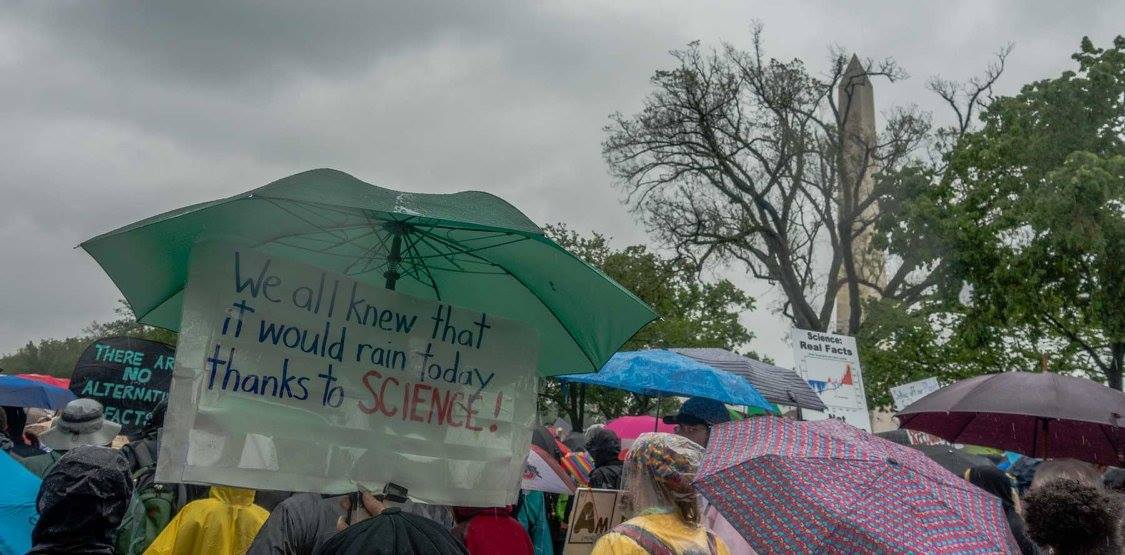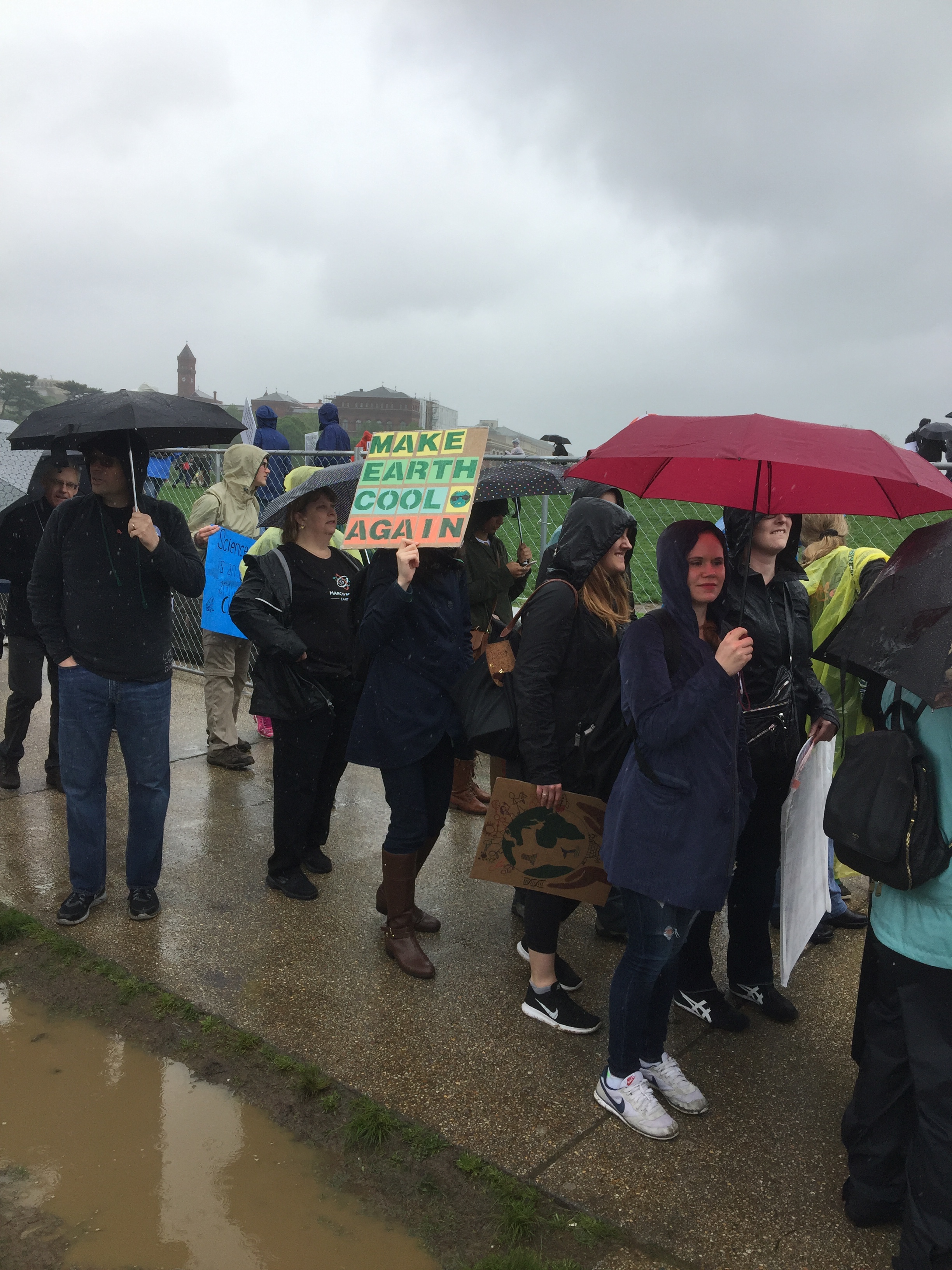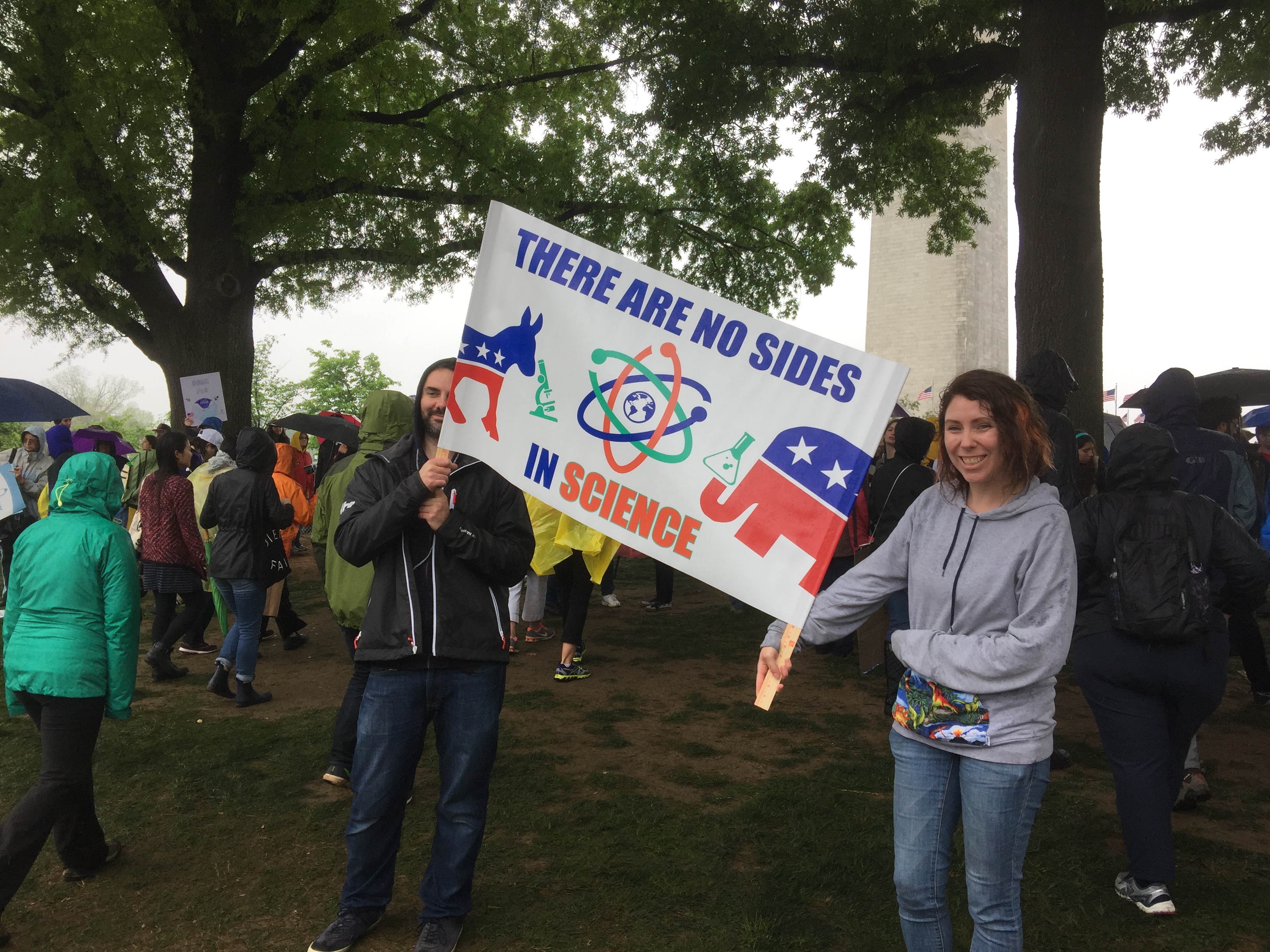“Scientists are a community of scholars engaged in a common search for knowledge.” – line (as I recall it) from my ninth-grade science textbook[1]
Yesterday had a lot of moving parts around our household, but a time window between noon and four o’clock allowed opportunity to hop on the Metro and for a couple of hours be a small part of the March for Science. To be at such an event is to enjoy a wonderful immediacy, involving all the senses, but at the expense of losing the bigger picture – something like the experience of a cork being flung here and there by big waves on an active ocean. (That bigger picture was captured well and truly by Washington Post reporters.)
Some of what (your cork-on-the-scene) saw and heard:
“Communogenesis:” in an analog to storm formation, this is how communities, tribes (the idea of we-they) get formed, strengthened. Shared experience and identity, bonding – it was all happening there. Even on the Metro ride downtown it was easy to spot the marchers versus the regulars – based on dress, signage, group size, and chatter.
The walk from the Metro station to the venue revealed four other already-formed, well-established communities: (1) Street vendors. Everywhere it would prove as easy to get the coveted tee shirt commemorating Earth Day and the March for Science – or an umbrella or poncho – as it is other places and other days to get Washington Nationals or Capitals shirts and caps. (2) Food trucks. They seemingly occupied every foot of curb near the venue. Queues were long. (I could move past these as my concerned wife had thoughtfully provided me enough food and water to last for two days, not two hours.) (3) Police. They were everywhere, focused on enabling the special events to proceed and co-exist with the ordinary weekend business of downtown DC – those who were downtown for other reasons ranging from work to tourism. It wasn’t always easy or smooth. At 14th and Constitution one pedestrian tried to cross against the police officer’s instructions. The officer didn’t just let it pass, but instead restrained the man, who then struggled, resisted, protested. Immediately a swarm of other police on motorcycles moved in. Interestingly, the few vocal voices at the intersection appeared to side with the police – apparently recognizing the need to deal with both motor and pedestrian traffic in a balanced way. (4) Suppliers of port-a-johns. At some points, seeing the lines of these arrayed over the Mall, it was possible to think they outnumbered the marchers.
Key point? All these communities are (like scientists themselves?) agnostic. They care less about the purpose of any large crowd than the management and service of it.
Our threefold relationship to the Earth: Those food trucks served as a reminder that Earth is a necessary resource – a resource each of us needed moment by moment. The rain drove home the reality that Earth is both a resource (DC is experiencing what residents consider a bit of a drought, though minor by western standards) and a threat. But the Earth was also victim. The very throng attempting to pay it homage was at the same time doing it harm. The Mall was a sea of mud and mangled grass, torn up by the trampling around of the crowd in the rain, disfigured by the fencing and tented checkpoints etc. set up for crowd control and security. This coming after last year’s lengthy and expensive restoration of the Mall to make it worthy of the nation’s capital. (Impossible to tell what damage was due to this March itself or the women’s march of a few months back.)
Messaging/Signage. As journalists have noted in numerous reports over all media, scientists have distinguished themselves with clever signage and tee shirts. You can find a sample –only one of many – here. I’ll just add a couple, starting with my (admittedly parochial) favorite:

photo by Maureen Spagnolo
This is the brainchild of and proffered by Dr. Laurie Geller, who is the senior program officer providing adult supervision for our National Academy of Sciences committee working on (not the exact title) a social and behavioral science research agenda for the Weather Enterprise. Dr. Geller reminds us that both meteorological science AND social science are needed to bring about not just the forecast but also the near-universal awareness.
Runner-up from my own photos of the event might be this one:

which (totally abusing the argot of wine connoisseurs) might be described as “complex, intellectually satisfying, with earth elements that give way to hints of politics.”
Honorable mention among my photos goes to:

Which is self-explanatory, and spot on.
ICYMI: couple of journalistic reflections on the March: a nice Washington Post piece yesterday by Michael Rosenwald wondering how the Founding Fathers might have reacted to a March for Science. Mr. Rosenwald accurately notes that science and politics weren’t at loggerheads back then. And Megan Mullin reflected on risks that the March might further politicize science.
A final thought: Both President Trump and House Science and Technology Committee Chair Lamar Smith issued Earth day/March for Science statements. Both drew flak. But no matter how tempting that response, scientists might better invite political leaders, and the public to join a process whereby we all see ourselves less as contending communities engaged in confrontation, and more as “a (single, unified) community… engaged in a common search for knowledge” – in the spirit of everybody’s ninth-grade science book.
______________
[1] This scientists-as-community ideal would later motivate a graduate-school decision to switch fields, from physics to geophysical science – one of the most felicitous decisions in my life, as I described in Living on the Real World.
